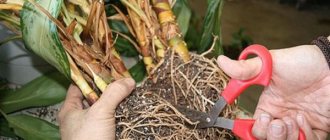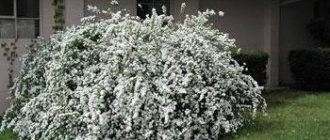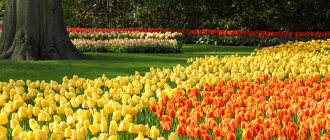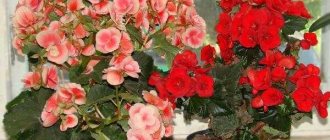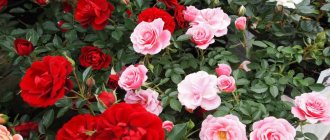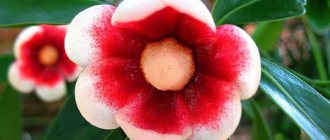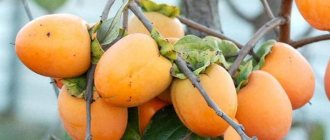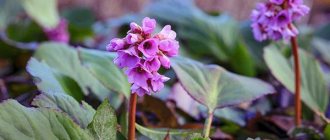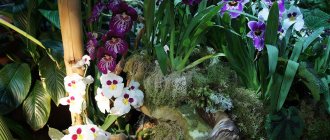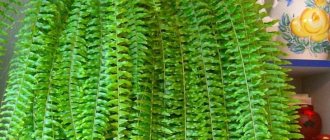Anthuriums are tropical plants. There are almost 550 species and more. The variety of colors of the inflorescences is amazing. Taking the main species, many interesting hybrids were developed. When growing these flowers at home, you have to maintain the conditions. The main feature of anthuriums is their aerial roots. Some of them may be in the soil, the other part moves away from the shoot. Thus, the roots search for nutrients and moisture. Many types of anthurium grow in trees in their natural environment. The root system is very similar to orchids.
To grow anthurium at home. It is necessary to recreate approximate conditions. Take care of the planting soil where this plant will grow. Take care of watering and fertilizing. Take into account temperature fluctuations. Depending on the time of year, anthuriums prefer different temperatures. In the tropics where these plants grow, humidity is very high. So this point also needs to be taken into account. It is also necessary to take into account the fact that plants in the house can be affected by pests and get sick; knowing this is also an important aspect.
Among the variety of colors on sale there are plants for every taste: blue anthurium, chocolate anthurium, blue anthurium, orange anthurium, yellow anthurium, burgundy, lilac. Even green anthurium and black anthurium flower can be found on sale if desired. Everyone will find both a large anthurium and a mini anthurium for themselves.
Types of anthurium.
Almost everyone has some type of anthurium in their home. Designers use it in interior design, flowers are used by florists. These beautiful flowers bloom for quite a long time. They retain their decorative qualities for a long time.
First, let's look at the main types of anthurium. Andre's anthuriums and Scherzer's anthuriums are the leaders among all. Anthuriums by Andre and Scherzer can almost always be found on sale. Regardless of the variety, all anthuriums are divided into those with decorative leaves and flowering ones. For indoor floriculture and interior landscaping, flowering anthurium species are mainly used, which are quite well represented in the color palette.
Varoka
The leaves grow up to 1 meter and up to 25 cm in width. The color is dark with silver-white veins.
Inflorescences on a short stalk reach 30 cm. More often found in the tropical forests of Colombia.
Plants differ in the presence or absence of a trunk, and sometimes climb. They are distinguished by oblong leaves that have a heart-shaped or elongated shape.
The surface is predominantly wavy, sometimes with light veins. Perennial plants are not easy to care for. They require moisture, diffused light and moderate temperatures.
If you are interested in learning about other types of anthurium, you can read the following articles:
- Anthurium Andre.
- Crystal anthurium.
- Anthurium Scherzer.
Anthurium Andre.
A very popular plant among all anthuriums. Thanks to him, many anthuriums were bred by breeders and began to sparkle with new colors. The leaf is heart-shaped, lush green in color, the root system is very well developed. Has a short barrel. The color of the inflorescences is multifaceted, so everyone can choose one or another plant for home use.
What does the plant look like?
Anthurium Leganza is extremely beautiful. The height of the plant at home reaches 90 cm (as mentioned above). Anthurium has large oval leaves up to 30 cm long and up to 12 cm wide. The leaves are green in color and pointed at the end. Against the background of large, bright, smooth leaves with sparse veins, there is a large yellow flower, shaped like a corncob with small balls (during flowering).
The flower is decorated with a beautiful heart-shaped bedspread of an orange hue. At the base, the orange tint gradually turns into green. And the older the plant, the more the green tint spreads across the cover and merges with orange.
Anthurium Scherzer.
Also very popular due to its dwarf shape. This handsome dwarf has won many hearts of flower growers. They are no more than half a meter in height. The stem is short, the leaf is ellipsoidal. This indoor flower smells pleasant when blooming.
– Tourenza variety, the owner of a lush bush and glossy leaves.
– champion pink variety, not a tall bush and lush foliage.
– Dakota variety, a large and quite bushy variety.
– Sierra Magic variety, compact shape, abundant flowering.
– baby boomer variety, inflorescences of two colors, red and green.
– leganza variety, has a large number of leaves. Anthurium leganza is very decorative.
– Jolie variety, fairly tall bush, tulip-shaped inflorescences.
– Bugatti Veyron variety, medium-sized bush, very beautiful inflorescences.
– Pandola variety is a compact bush, the leaves are not large.
– Pink Alabama variety, large bush, with beautiful inflorescences.
– Pink Queen variety – medium bush, many leaves and abundant flowering.
– baby orange variety – very unique coloring of inflorescences.
– Medural orange variety – large and beautiful inflorescences.
– Almera variety – bright red inflorescences.
Next, let's look at certain types of anthurium; they can be classified as decorative, thanks to the juicy and unusual features of the leaves.
Anthuriums Tulip with tulip-shaped cover
Anthuriums of the Tulip variety are becoming increasingly popular due to the unique shape of the spathe and the shape of the entire inflorescence. Today in culture there are red, pink, white, purple, lilac and blue anthuriums of this type.
Anthurium Fiorino with a tulip-shaped cover of a rich pink-violet hue belongs to the group of small anthuriums. The shape of the inflorescences is very laconic, and thanks to it the plant easily fits into any interior. The colors of the spathe and the spadix of the Fiorino anthurium are bright, and flowering lasts about 4 months.
The blue anthurium Princess Alexia Blue will not amaze with the size of the inflorescence, but it will certainly not leave indifferent lovers of unusual colors. Both the cob and the spathe of this variety are painted in a beautiful ultramarine hue. But as it matures, green strokes appear at the base of the bedspread.
No less bright is the yellow anthurium of the Princess Alexia variety with a small bract and a short straight cob. The bright inflorescence is perfectly visible against the background of compact dark foliage.
Anthurium variety Joli is a miniature representative of a large family of indoor plants. The size of the rosette does not exceed 15–18 cm, which allows you to find a place for a rather small anthurium with a pink bract and the same spadix on the tightest windowsill.
Other types.
Crystal Anthurium has fairly large leaves. For this he is highly appreciated. It is difficult to find on sale, since it is more often found in its natural growing environment. The main decoration of this species is the unusual patterned design on the leaf that crystal anthurium has.
Anthurium majestic - similar to crystal anthurium. The leaf is also quite large.
Anthurium dissected is a compact type of anthurium. Grows like a liana.
Baker's anthurium is a long leaf with an unusual shape.
Climbing Anthurium has thick roots and stems and can take the form of a vine.
Anthurium Scherzer and Andre (mix) – bred dwarf form.
Among the majority of anthurium varieties, these are the most popular: baby boomer, cavalli, white champion, red champion, pink champion, Dakota, Fiorino, Princess Alexia Blue, Princess Amalia Elegance, Sierra Magic, Tourenza, Utah.
As you understand among the representatives, they can be used from the point of view of the decorativeness of the leaves, or the beauty of the inflorescences.
Next, we will try to collect the main varieties according to color scheme.
The classic color is red anthurium and all its shades. From scarlet to burgundy.
Red anthurium - a flower from an old legend
A bright glossy blanket and a yellow spadix consisting of many tiny flowers.
This is what a classic anthurium looks like, the legend of its origin has been remembered for many centuries in South America. The young beauty sacrificed her own life in the name of love and fidelity. Amazed by such selflessness, the gods turned the unfortunate woman into a scarlet flower with a single petal in the shape of a girl’s heart.
Red anthuriums are still considered classics today and are highly valued among gardeners.
Anthurium Dakota can rightfully be called the most famous and widespread variety. At the same time, the plant stands out not only with the rich color of the bedspread, but also with its size from 14 to 23 cm. A large, spectacular plant cannot be ignored even in a very spacious room.
The name Anthurium comes from Anthos - flower, and Oura - tail. But no less than the tail, the cob resembles the long neck of a flamingo. But unlike flamingos, anthurium today can have more than just red or pink colors.
Anthurium inflorescences of the Minnesota variety stand out from a number of equally spectacular plants with bright scarlet bracts and cobs that change color first from white to yellow and then to green.
The group of Red anthuriums, with the predominant color of the cover being red, is very large and diverse. This also includes Anthurium Edison, which is presented on store shelves not only with plants with red inflorescences, but also with varieties that bloom in pink tones.
In addition to scarlet and classic red varieties, you can find Dark Red Anthurium. The bracts of such anthuriums, as in the photo, come in all shades from crimson, wine to burgundy, brown or almost black.
An example of a brown anthurium is the Otazu Brown variety with a deep burgundy heart-shaped spathe and a straight light green cob.
Anthurium varieties Utah readily form solemn large inflorescences with a glossy textured blanket with a diameter of up to 14 cm. The spadix and bracts of anthurium are violet or deep purple. At the same time, older inflorescences can be easily identified by the green tint at the base of the bedspread.
Luxurious black anthurium Black queen appears even darker thanks to the light color of the cob. On the surface of the dense, glossy bract, all the veins stand out in relief, giving the inflorescence a simply fantastic look.
The luxury of red.
These anthuriums include the following varieties: Success red - very brightly colored in a rich red color. Royal champion and Dynamite ed. These varieties have good decorative qualities; they can be grown in single plantings or in composition with another anthurium variety. Variety: Dakota, Sierra Magic, Tourenza. Almera, Bugatti Veyron, Champion Red, Red King, Baby Boomer.
Plowmanii
Anthurium Plowmanii is named after the botanist Timothy Plowman, who discovered and cataloged a large number of flowers from the Amazon. It grows in various parts of South America at altitudes ranging from sea level to 3,000 feet and tolerates dry conditions much better than many other members of the anthurium family.
It can grow to a decent size and grows in what is sometimes called a bird's nest shape; if you use your imagination it looks like a bird's nest, perhaps for a pterodactyl.
Pink tenderness.
Pink anthurium is also popular and competes with red and white. You should pay attention to: Princess Amalia Elegance - has very bright inflorescences, pink in color, the inflorescence is interesting in its shape, California - a large anthurium with a pinkish color, smoothly turning into reddish., Flamingo pink - a godsend for home floriculture. The inflorescence is pink, rather pale pink, delicate. Feature in purple cobs. Arisa pink, also the owner of a pink inflorescence. The Love series contains many shades of pink. Anthurium flamingo - also pink inflorescences. Other varieties with pink inflorescences include: Jolie, Lady Love, Pink Alabama, Pink Champion, Picasso Pink, Pink King, Pink Queen. With a green tint: lava fantasy. Leganza. Anthurium pandola, anthurium arisa pink.
Yellow anthuriums and Orange varieties
The Picasso cultivar group includes Orange anthuriums, like this one pictured, as well as plants with pink, purple, blue and white bracts.
According to the description, Picasso anthuriums are small plants suitable for growing indoors. The color of the spathe, which thickens towards the tip and base, gives the inflorescences a special charm, which makes the flower more voluminous and bright.
The yellow anthurium shown in the photo belongs to the Lemona variety. This inflorescence has a large spathe of a delicate lemon shade and a white spadix with a green tip.
The tenderness of white.
White has always been considered classic. As is red. Therefore, white anthurium can be combined with almost any other color, a good solution in creating a composition. Sumi varieties - the white inflorescence begins to turn green over time. Adios white is a tall anthurium. Its white inflorescences are decorated with a bright yellow cob. The inflorescence is white and tulip-shaped. Champion white variety - dwarf anthurium. Princess Amalia Elegance variety.
Features of caring for anthurium at home
Basic rules to follow:
- Correct selection of the pot - it should be a little cramped, otherwise the above-ground part will not develop until the roots completely entwine the earthen ball.
- You can buy soil at a flower shop. There are mixtures created specifically for it.
- Temperature in summer +20..+28 °С, in winter +15..+20 °С.
- Constantly maintaining high air humidity.
- Regular watering, spraying, wiping the leaves with a soft cloth, sprinkling is possible.
Interesting! Like any inhabitant of the tropics, this exotic prefers bright but soft light. It will not grow and develop in the shade, but it should also be protected from exposure to direct sunlight; the foliage is sensitive to burns.
Sunny yellow.
These varieties have rich yellow inflorescences. Varieties: Picasso yellow, Princess Alexia yellow, vanilla. The color can be either deep yellow or lemon.
When choosing anthurium for home cultivation, you should study the rare varieties of anthurium, what colors are available, study the types and varieties of anthurium, as well as the varieties of anthurium
Possible difficulties
The purchased flower is immediately freed from the store-bought substrate, since it requires special watering and is not suitable for the home area. The most common disease is rotting of the roots and stem parts due to excess moisture and low temperature . Anthracosis - drying out of leaf blades. Fungicides will help fight the disease. A small amount of calcium causes the ends of the leaves to turn black. The leaf part curls in dry air and insufficient light.
To avoid possible difficulties and withering of the plant, you must adhere to the rules of care . Only an integrated approach will help you enjoy lush flowering and colorful views.
Blue miracle.
Although it is believed that there are no such shades of anthurium in nature and the effect is achieved with coloring ink, which is added during cultivation. But it is worth noting the Princess Alexia Blue and Picasso Blue varieties.
If you decide to purchase one or another variety of anthurium, you need to consider several important points when choosing:
You should always inspect the appearance of the plant. It must be healthy, without signs of illness. Be sure to inspect the root system. You also need to understand whether the plant is flooded or in good quality. This can be assessed by the earthen lump, either the plant was overdried and then watered, or it was watered too much. The root system will tell you about this. The lump should be easy to remove from the pot. In any case, always choose a healthy plant. And your intuition will tell you the variety and color. Good luck to you.
Black
The luxurious anthurium variety Black Queen is a popular large-sized hybrid. On the surface of a dense, glossy black bract with a burgundy tint, all the veins stand out in relief, which creates a particularly impressive flower.
Thanks to the light green color of the cob, the color of the bedspread appears even darker.
The foliage part of the plant consists of large leaf blades of a dull green hue with light veins.
You can take a closer look at the Black Queen anthurium in the video:
Description
The genus Anthurium, which unites herbaceous evergreens, is part of the extensive arum family. Its range is the South American continent and Central America, where its representatives are found in subequatorial rain forests and mountainous areas in all their diversity. Most of them have adopted an epiphytic and semi-epiphytic lifestyle, existing in close contact with large trees. The genus also contains many long-stemmed liana-like and terrestrial herbaceous creeping forms.
Representatives of the Anthurium genus owe much of their decorative properties to evergreen leaves with a leathery texture. In shape they can be solid, incised, deeply dissected. The variety of leaf colors is also impressive: in some plants it has a delicate velvety tint, in others it has a luxurious satin sheen, in others, silver veins appear on a green background.
There are many large-leaved, ornamentally painted varieties.
The main advantage of these exotics is their incredibly beautiful flowers. They themselves are small and collected in long, dense cylindrical, tapering at the end, straight or curved tail-shaped inflorescences-cobs. Around each cob there is a bract (bract) - a blanket whose size and color vary depending on the species. Its surface can be shiny, glossy or matte, pubescent. The fertilized ovaries of faded plants form fruits with juicy pulp and berry-like shape.
Transfer
The frequency of transplantation depends on the age of the flower. Young indoor plants are transplanted every year into new soil and a larger pot. At the age of 3–4 years, it is enough to change the pot after the previous one is completely filled with roots.
Anthurium is characterized by a comfortable existence and flowering in a cramped pot. You should not increase the volume of the flowerpot unless absolutely necessary, as you may not see the flowers. At the bottom there are obligatory large holes for draining water; from the inside, a quarter of the space is filled with a drainage layer. For moisture, aerial roots are wrapped in sphagnum moss and sprayed regularly.
Priming
Anthurium prefers light substrates with good permeability to air and moisture. You can purchase ready-made soil for orchids: they are similar in the type of growth on trees in the natural environment.
Seedling care
Seeds planted in the ground germinate when a favorable microclimate is created: 25 ° C with diffused lighting and regular ventilation. Before germination, it is better to make a greenhouse for the seeds , covering the pot with a jar or film.
In such an environment, you can wait up to 2 months for sprouts to appear.
Picking
Picking is carried out when seedlings grow into large containers. A total of 3 transplants will be required, the last one places the young anthurium in a permanent pot.
Transplanting seedlings
Transplantation is carried out very carefully together with a lump of earth, so as not to injure the roots. It is important to leave the trunk about 5 cm above the ground, otherwise the plant may die.
Graft
Anthuriums are not usually vaccinated.
Formation of caudex and roots
The top of the old anthurium is wrapped in moss and moistened. After the roots have sprouted, you can cut and plant the young plant in the ground.
